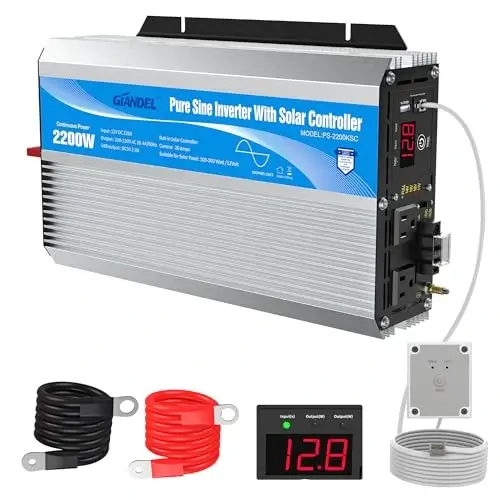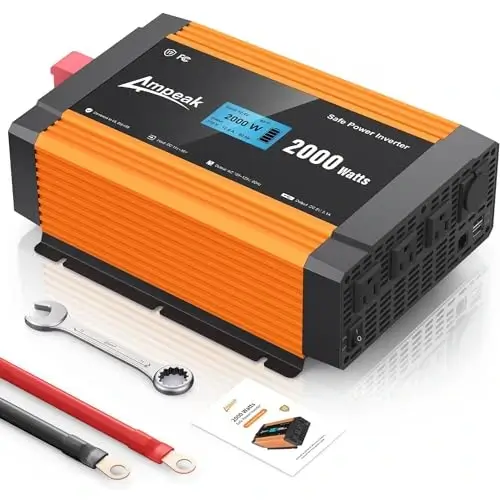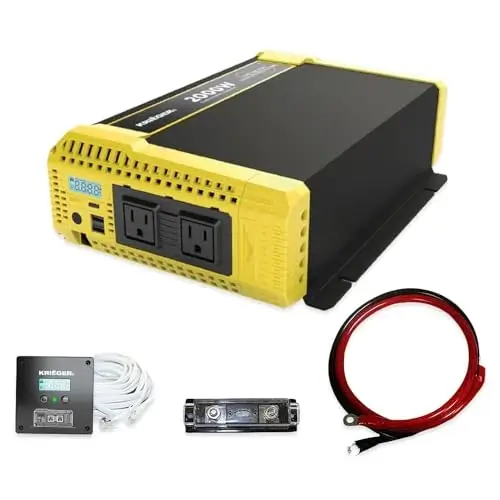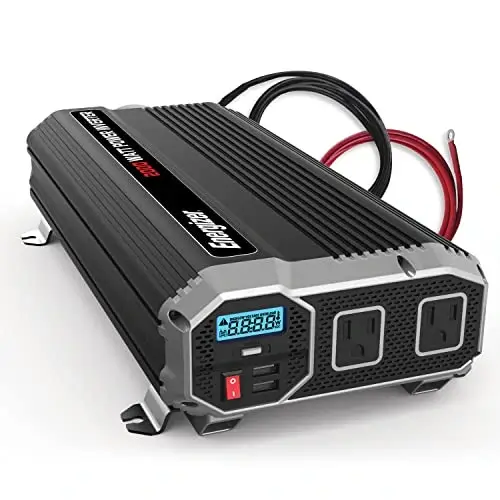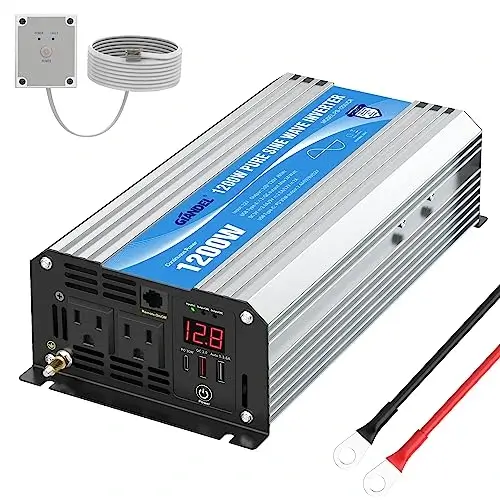Juice up, motor-homies. We’re talking about the best RV inverter charger for your rig today!
Now, nobody likes talking about RV electronics. It’s daunting. It can be demoralizing. Heck, it can be dangerous!
But that’s why you come to RVProperly. For our comprehensive no-baloney guides! Using my years of expertise vanning around the nowhere-lands nerding out on all things RV gear, I’ve rounded up the 6 BEST RV inverter chargers on the market.
The top pick is easy. The GIANDEL 2200W Pure Sine Wave Inverter steals the show for its all-around top performance at a very reasonable price point. Plus, it’s a pure sine wave inverter. We’ll cover what this means in more depth shortly, but it basically amounts to the best device compatibility.
That’s the simple answer. But I have more answers! While the jack-of-all-trades product is good for many, it’s not perfect for everyone.
So step right up to some delicious knowledge. There’s an inverter for everybody, and I have the six best right here. What are the other five?
The answer might shock you. (Hurhurhur.)

The Best RV Inverter Chargers: Our Top 6 Picks
- GIANDEL 2200W Pure Sine Wave Inverter [Best Overall]
- Victron MultiPlus 3000 [Best Splurge]
- Ampeak 2000W Power Inverter 6.2A [Best Budget]
- Krieger 2000 Watt 12V Pure Sine Inverter [Best Quiet]
- Energizer 2000 Watts Modified Sine Wave Inverter [Best Installation]
- GIANDEL 1200 Watt Pure Sine Wave Inverter [Best for Low Loads]
What Does an Inverter Do in an RV?
Alright! Let’s start with the basics.
An power inverter converts the DC power stored in your rig’s batteries into AC power. To get even more basic, DC power is what charges your devices (such as through your RV’s cigarette lighter port). AC Power is what powers most of your household appliances (through standardized outlets).
Think of an inverter as a translator for electricity. Without an inverter, you’d be stuck with only 12-volt power. You might be able to operate a more modest budget-friendly portable fridge-freezer. But without AC power, there’s no full RV fridge, no comfy heater, no luxe espresso machine…
You get the point.
Inverters come in various sizes and capacities, typically ranging from 1000 to 3000 watts. When choosing one, consider the total wattage of the devices you plan to run simultaneously. Selecting the right inverter for your total ensures you always have enough juice in your caboose no matter where the road takes you.
But this means you also need to know what type of inverter you need…
What are the Types of RV Inverters?
Essentially, there are two main types of inverters to consider:
- Pure sine wave inverters
- Modified sine wave inverters
Each type of inverter has its own advantages and ideal use cases. So let’s jack in and shed some light on this topic!
Pure Sine Wave Inverters
Pure sine wave inverters produce a smooth and consistent wave of electricity. In that sense, they function more or less like the power from your home outlets. That’s why they’re ideal for sensitive electronics like laptops or microwaves.
These inverters are the more expensive type admittedly. However, they ensure all the best RVing gadgets and gizmos run smoothly and without interference or risk of damage. If you rely on electronics that need clean power and don’t want to run the risk of any expensive damages, pure sine wave inverters are the way to go!
Modified Sine Wave Inverters
Modified sine wave inverters create a stepped, approximation of a pure sine wave. They’re more budget-friendly but with the expected caveats that come with budget products.
The approximated wave works fine for simple devices like lights, fans, and basic kitchen appliances. But it’s just not the best choice for sensitive electronics. They can cause interference or even damage devices over time.
These inverters are good if you’re sticking to basic appliances and want to save some cash. However, if you work on the road, operate laptops, or just have a souped-up glamping-mobile stacked with high-level appliances, a modified sine wave inverter just won’t cut the mustard.
Which Inverter is Better for RVing?
Choosing between a pure sine wave and a modified sine wave power inverter depends on your power needs (as well as your budget). If you run delicate electronics, a pure sine wave inverter is the safer bet. Like any great relationship, you’re paying a premium for reliability and consistency.
But if you’re on a tighter budget and only need to power lower-key gear, you can consider a modified sine wave inverter. It’s more affordable and will handle most basic appliances well. Of course, like a less great relationship, it might also conk out on you at any time!
So really, go per your power needs. That said, if you have the extra cash in the budget, there’s no reason not to shell out for a pure sine wave inverter for its higher performance. Out on the road, reliability is the one true key to success.
The 6 Best Inverters and Inverter-Chargers for RVs Reviewed
Okiedoke! Now that you’ve been illuminated on the topic, let’s get to the good stuff… Product reviews!
Pair any of these whizz-bang units with a top-performing RV battery and you’ll be living in such luxury you’ll think you never left home. With more sine waves than you can shake a stick at, here are the 6 BEST RV inverter chargers for your dollaridoos.
Best Overall
1. GIANDEL 2200W Pure Sine Wave Inverter
- AC Connections: 2 slots
- DC Connections: 1 slot
- Dimensions: 15.7” x 9” x 3.5”
- Weight: 12.9 lbs
The GIANDEL Pure Sine Wave Inverter stands out as the single best all-around choice for RVers. It’s durable, it oozes performance, and it’s overall just electrifyingly good value.
Heavy-duty and rugged, the GIANDEL houses hardwire terminal blocks and pure copper cables. This combo ensures it can effectively handle up to 2200W loads.
Additionally, it’s got a little LED display for staying on top of your metrics on the go. AND (the feature I’m a big fan of) a 15-foot wired remote control! Hook this in and set it up in your RV for hassle-free operations.
I must admit that the cabling included in the package is a bit subpar. It’s functional… But for the best longevity and performance, I would advise upgrading it with something more bespoke.
But if you’re happy to make that swap, you’re in for a treat! This inverter is neither the beastiest nor the most feature-loaded on the list, but that’s why it’s the best! It’s an overall high-performing and no-fuss unit with enough wattage for all but the most opulent motorhomes.
If you value reliability and consistency in power usage, then GIANDEL is the choice for you. Like all good relationships, this is one that will last you a very long time.
Best Splurge
2. Victron MultiPlus 3000
- AC Connections: 2 slots
- DC Connections: 1 slot
- Dimensions: 8.6” x 14.3” x 10.2”
- Weight: 39.6 lbs
If a jack-of-all-trades ain’t your man, how about that beastier unit? The Victron MultiPlus is a splurge-worthy investment for serious-bizz RVers!
This unit not only has a serious power inverter, but an equally impressive battery charger that can meet all your charging needs. It’s a high-end unit delivering top-shelf performance and advanced features in spades. Forget budget portable fridge-freezers: this is the system to run that full-sized, full-power RV refrigerator you’ve been dreaming of!
On the note of features is its robust PowerAssist Technology. This mechanism prevents overloading by boosting output with extra battery power when the connection is limited. This means a more seamless flow of power and, most importantly, much more peace of mind.
Now, take this and pair it with the Victorn’s remote monitoring and controls and you’re in for a good time! If you have a GX device on hand (like the Cerbo GX), you can monitor and control your system locally or remotely via the internet. It’s tech-savvy for sure but a massive win if you’ve got the know-how!
My biggest gripe is that the unit lacks a display. Rather, it relies on LED lights to convey status information. This is less than ideal for quick analyses and a bit odd as LED displays are pretty standard on inverters. It’s also a bulky and heavy piece of gear, which complicates the installation relative to smaller units
Despite these drawbacks, the Victron packs a wallop. And that’s what you buy it for! If you have space for it and need top-level output, it’s a worthy investment. Otherwise, the GIANDEL offers a simpler but still very powerful alternative.
Best Budget
3. Ampeak 2000W Power Inverter 6.2A
- AC Connections: 3 slots
- DC Connections: 3 slots (2 USB-A + 1 cigarette lighter)
- Dimensions: 11.0” x 7.3” x 3.5”
- Weight: 7.5 lbs
In contrast to comprehensive, all-power units we have the Ampeak. This budget-oriented option balances serviceable power capacity with much more reasonable pricing.
Despite its cheaper leanings, one thing Ampeak does not skimp on is safety! This inverter features a staggering 17 total protective features, including mechanisms for…
- Reverse polarity
- Overload
- Over/under voltage
- Overheating and high temperatures
- And short circuiting
This multifaceted protective framework ensures your devices (as well as the inverter itself) are well-protected.
The Ampeak inverter also boasts an LCD display. While displays are relatively standard for inverters, this particular display goes HARD on monitoring. There’s a whole swathe of awesome metrics for gear-nerds like me. The level of insight he Ampeak provides is crazy handy for efficient power management.
The downside to this cheap-but-top performer? Welllllll… it’s a modified sine wave inverter. As described above, that makes it an unreliable and potentially harmful choice IF you have sensitive electronics. For example, you could run a basic space heater in your RV with the Ampeak, but more advanced models – such as ones with electronic thermostats and control units – would be pushing it.
But for RVers with lower power needs and looking for a price to match, the Ampeak Power Inverter is a stellar choice! Its robust monitoring and safety mechanisms ensure an efficient device. Meanwhile, the price…?
Well, you just can’t beat affordable!
Best Quiet
4. Krieger 2000 Watt 12V Pure Sine Inverter
- AC Connections: 2 slots
- DC Connections: 2 slots
- Dimensions: 9.8” x 15.8” x 3.9”
- Weight: 13.9 lbs
Ok, so the thing about inverters is that they aren’t always quiet. The wrong model will 100% ruin your peaceful outdoor ambiance. So, instead, swing for something that proudly promotes whisper-quiet operations like the Krieger!
The Krieger uses an ultra-quiet high-speed cooling fan for doubling safety with serenity. This fan runs significantly quieter than other comparable models on the market. Plus it prevents overheating and keeps the inverter operating smoothly under heavy loads, meaning more efficiency for fewer decibels!
Beyond that, the Krieger inverter features an LCD display and plenty of safety features. It’s also a pure sine wave unit, so even your delicate electronics will be fine and dandy.
No product is perfect though, and the quirk here is an odd one. I’ve heard reports that this inverter emits certain radio frequency interference (RFI). This can affect devices unexpectedly, most crucially ham radios and other communication devices.
This is unlikely to affect most RVers. However, if you rely on such communication devices (e.g., for safety reasons if you enjoy RVing and boondocking off-grid), consider this before committing to a buy.
Despite this very specific drawback though, the Krieger is an otherwise excellent choice of inverter. And especially so for anyone who prioritizes quiet operations in the great outdoors. It’s very similar to the GIANDEL in performance but just a bit more chill-friendly.
Prioritize peace! Especially in your lakeside camps. After all, the only thing that beats affordability is serenity. 🙂
Best Installation
5. Energizer 2000 Watts Modified Sine Wave Inverter
- AC Connections: 2 slots
- DC Connections: 2 slots
- Dimensions: 15.5” x 7.7” x 3.5”
- Weight: 7 lbs
Installing an inverter… Yuk! Electrics and cabling – nobody wants that!
Enter the Energizer Inverter. A no-fuss, no-muss, easy installation inverter. It’s a top pick for less tech-savvy RVers!
With a straightforward setup, detailed instructions, and no shortage of customer support from a trusted brand, getting this inverter up and running is a breeze. It’s even got a two-year warranty, which is easily extendable to three. All you gotta do is register and leave a review for the product (good or bad). Even that part is straightforward!
On top of this, it has a comprehensive LED display AND Smart Chip Protection for total safety. All of the inverter’s protection statuses are displayed on the LCD screen too for straightforward use. Pair it with a comprehensive surge protector to guard your RV against unforeseen electrical faults, and there will be no unexpected curveballs with this device!
Now, keep in mind that this is a modified sine wave inverter. Like the AMPEAK, it’s not ideal for more sensitive electronics. If you have more diverse power needs, you might want to consider pure sine wave options like the GIANDEL or Krieger instead.
But for straightforward setup and use, this is the inverter for you. Hassle-free and budget-friendly, it’s perfect for those who want a reliable power solution without the complexity. Just get it up and running and it’ll be many happy days of RVing ahead.
Best For Low Loads
6. GIANDEL 1200 Watt Pure Sine Wave Inverter
- AC Connections: 2 slots
- DC Connections: 3 (2 USB-A + 1 USB-C)
- Dimensions: 11.2” x 5.5” x 3.0”
- Weight: 5.6 lbs
Budget-friendly like the Ampeak but with pure sine wave functionality, this is GIANDEL’s lower-wattage model. If you need fewer watts than the Giandel 2000W, this is the way to go for top performance at a lower price.
It’s really much the same as the 2000W model except cheaper. The same safety protections, the same nifty LED display, and the same 15-foot wired remote control. Really, everything I said about the first GIANDEL unit still stands here!
Meanwhile, the main drawback is that the 1200W capacity is realistically more equipped for operating a few quality-of-life RVing accessories rather than a full home office setup. It’s ideal for anyone with lower power demands (regardless of device sensitivity), but it’s less ideal for everyone else. Oh, and same as the previous GIANDEL, I strongly recommend upgrading that cabling.
Overall though, the GIANDEL 1200W Inverter is spot on for peeps who just don’t need the extra wattage. It offers ample slots (more than the 2000W model actually!), top performance, and reasonable pricing. If your power needs are modest, this inverter will serve you well.
How to Calculate the Right Inverter Output for Your RV
Ok, now for the fun stuff: math!
Calculating the right inverter size for your RV ensures you have enough power for all your gadgets without overloading your system. With some wee calculations, this is pretty simple to figure out.
What’s the Ideal Inverter Capacity for My RV?
The ideal inverter size depends on the total wattage of all the appliances you plan to simultaneously run. The most common range for RV inverters is between 1000 and 3000 watts. Something in here will meet most RVer’s needs.
For most setups, a 2000-watt inverter is a good balance. This will handle a mix of appliances and electronics comfortably. That said, it’s still smart to do some deductions of your own.
First, Figure out the Total Wattage of Your Appliances
Ok, so understanding RV electrical systems in full is admittedly quite a rabbit hole. Luckily, we’re going to keep things simple by focusing only on the need-to-know aspects of purchasing an inverter for your rig.
Start out by listing all the appliances you’ll want to use simultaneously on the adventures. Then, check each device for its wattage rating. This is usually found on a label or in the user manual.
As a rough idea, common appliances and their approximate wattages include:
- Microwave: 900-1200 watts
- Coffee Maker: 600-800 watts
- Laptop: 50-100 watts
- TV: 150-400 watts
Once you’ve established your common devices, add up their wattages to get your total power requirement.
Then, Apply the Calculation Formula
Ok, math time! To find the inverter size you need, use this simple formula:
Total Wattage of Appliances + 20% for a Safety Margin
For example, if your total wattage is 1500 watts, add an extra 20%, making it 1800 watts. This ensures your inverter can handle the load without overextending itself. So, in this case, you’d look for an inverter around the 2000W mark.
(Alternatively, here’s a free tool for calculating power inverter requirements to make things easier!)
By calculating correctly, you ensure your inverter meets your power needs without any hiccups. In turn, this ensures a smooth and enjoyable RV life!
Our Verdict: What’s the Best Inverter Charger for RVing?
And that’s the full circle! The 6 BEST RV inverter charger, plus a lot of bonus handy info. Because you’re worth it.
For the final time, my hands-down top pick of inverter charger is the GIANDEL 2200W Pure Sine Wave Inverter. While it’s not the master of any category, I am ALWAYS a fan of reliable performance and sheer affordability in one neato package.
But otherwise, find the inverter you need! We have the 1200W GIANDEL Pure Sine Inverter if that model suits your needs better. Plus GIANDEL (and several of the other brands on this list) also offer higher wattage models for truly luxurious RVing!
And if none of that works… Well… Maybe stay at home. There’s always reliable power there!
But really, that’s boring. RV life is about experimenting, and that even means your electronics. Suit up, plug in, and hit the road! (With power.)
Because at the end of the day, your morning brew always tastes better accompanied by gentle birdsong and iconic vistas. Happy travels!

